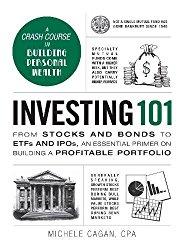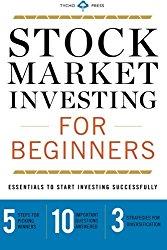
So you’ve paid off your credit card debt, paid off your car, and you’ve shifted to a 15-year mortgage that you’ll pay off in 12. Now you’re wondering, what’s next? The answer is: Investing.
Many people have heard that it is good to invest in stocks and build up a portfolio but don’t know how to start. In this article I’ll go over some of the basics to get you started. There is really no secret to stock investing – it is just a matter of investing regularly, understanding risk, and properly evaluation companies for potential return.
The first concepts that one must understand are volatility, diversification, and time frame. First, we will discuss volatility. Stocks and other assets go up and down in price. It is not like a bank account where one can calculate the interest rate and know the value at a future point in time. One must therefore not invest money needed in the next few years; however, by taking on more risk, one can make returns that are much better than bank rates.
The potential return on an investment is proportional to the volatility. Bank accounts and CDs are not volatile – the rate of interest is easily calculated such that the value at any given time will be known. There is a slight risk that the bank may close and not be able to repay the money — a risk that was reduced after FDIC insurance was started — but most fo the time the money is repaid and one is able to ask for the money back at any time, albeit with a forfeiture of interest some times.


Great beginner investment guides.
With stocks and bonds, the value of the investment fluctuates with time. One can not be certain what the value will be tomorrow or the next day, or even next year – it is whatever someone is willing to pay for the stock or bond at the time. For a stock one can assume that the price will be close to where it was the day before, but news — good or bad — can cause the price to move by 10% or more in a day. Sometimes a stock will rise or fall for reasons that have nothing to do with the company. The whole market will move due to word of recession, war, pending legislation, or other events. Sometime it is just movements of the stock prices themselves or various trading strategies that are being employed that will cause a stock price to move precipitously.
It is this volatility, however, that makes stocks grow more over time and provide a greater return than safer, fixed income investments. Because there is risk involved, one is able to buy stocks at significant discounts to what the earnings prospects of the company indicate the price will be. Because the company may not make the earnings, and later pay the dividends, that are expected the price will drop until it is low enough to justify the risk taken.
To reduce risk caused by uncertainty and volatility, one uses diversification. Diversification is spreading out one’s money over several stocks. It is uncommon, but not unheard of, for single stocks to drop by half or more over short periods of times. If a scandal breaks out or a large lawsuit occurs, a stock may go bankrupt in a period of days. By buying several stocks, however, a loss will be limited even if a single stock in the portfolio drops to zero. If one owns 10 different stocks in equal amounts, one can only lose 10% in any individual stock. If one buys a significant number of stocks, or buys a few mutual funds, one will get about the return of the market, which generally ranges between about -10% and +15% in a year, but can see swings of between -50% and +100% in a year time period. During the Great Depression, the market fell by 90%, but then proceeded to rally back, increasing tenfold (1000%)in the years that followed.

Want all the details? Try The SmallIvy Book of Investing.
The third concept is time frame. Because stocks are volatile, it is difficult to predict price over short periods of time, between one and three years. Over five to ten-year period or longer, however, stocks tend to rise. Returns on stocks over long periods of time have averaged between ten and fifteen percent — much better rates that most other investments. Also, buy buying shares regularly, rather than putting all of one’s money in at once, one can do even better since more shares will be bought while prices are low than when they are high. This process, called “dollar cost averaging,” is a popular and effective technique.
The best strategy therefore is to:
1)Invest only with money that is not needed in the next several years. If the money is needed, it is better to forego the added return and just keep the money in cash.
2) Have only as much money in a single position as you would be willing to lose. As the amount of money invested increases, the money should be spread over more and more stocks and into other assets such as bonds to reduce risk.
3) Invest for the longterm. Select stocks that have earnings that are growing steadily and have lots of room to expand. Once you have invested, then ignore the price fluctuations that occur and focus on the earnings. As long as earnings continue to increase, the price will also, eventually. Remember that time is on your side – if things look bleak, just ignore it for a while. A rally will eventually come.
Have a burning investing question you’d like answered? Please send to [email protected] or leave in a comment.
Follow on Twitter to get news about new articles. @SmallIvy_SI
Disclaimer: This blog is not meant to give financial planning or tax advice. It gives general information on investment strategy, picking stocks, and generally managing money to build wealth. It is not a solicitation to buy or sell stocks or any security. Financial planning advice should be sought from a certified financial planner, which the author is not. Tax advice should be sought from a CPA. All investments involve risk and the reader as urged to consider risks carefully and seek the advice of experts if needed before investing.
Advertisements